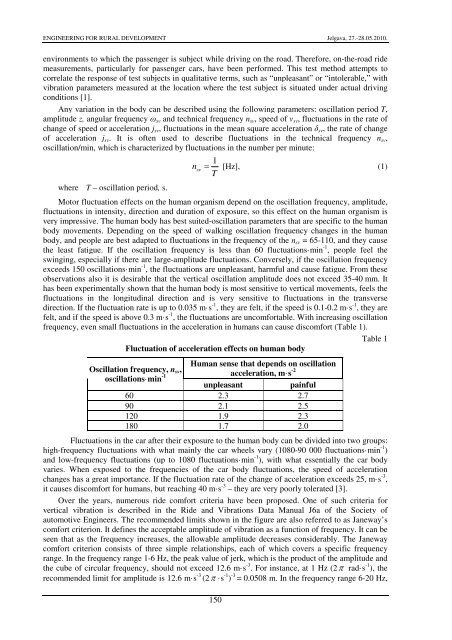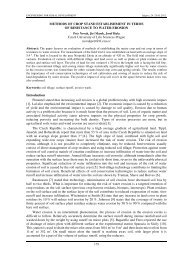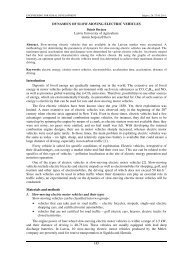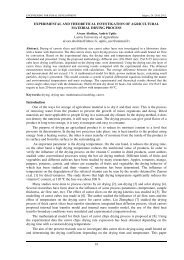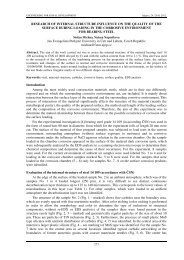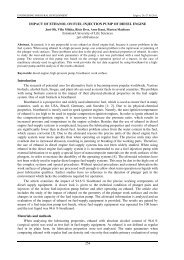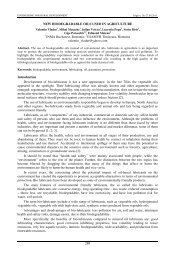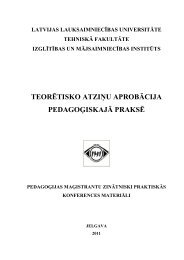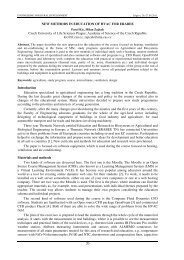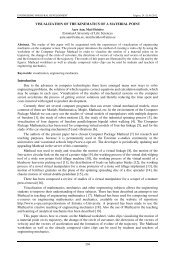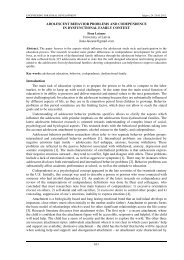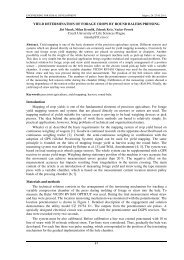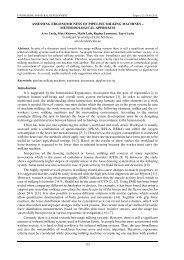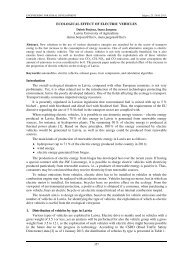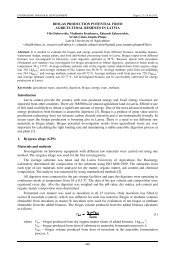experimental investigation in acceleration of vehicles
experimental investigation in acceleration of vehicles
experimental investigation in acceleration of vehicles
Create successful ePaper yourself
Turn your PDF publications into a flip-book with our unique Google optimized e-Paper software.
ENGINEERING FOR RURAL DEVELOPMENT Jelgava, 27.-28.05.2010.environments to which the passenger is subject while driv<strong>in</strong>g on the road. Therefore, on-the-road ridemeasurements, particularly for passenger cars, have been performed. This test method attempts tocorrelate the response <strong>of</strong> test subjects <strong>in</strong> qualitative terms, such as “unpleasant” or “<strong>in</strong>tolerable,” withvibration parameters measured at the location where the test subject is situated under actual driv<strong>in</strong>gconditions [1].Any variation <strong>in</strong> the body can be described us<strong>in</strong>g the follow<strong>in</strong>g parameters: oscillation period T,amplitude z, angular frequency ω sv and technical frequency n sv , speed <strong>of</strong> v sv , fluctuations <strong>in</strong> the rate <strong>of</strong>change <strong>of</strong> speed or <strong>acceleration</strong> j sv , fluctuations <strong>in</strong> the mean square <strong>acceleration</strong> δ sv , the rate <strong>of</strong> change<strong>of</strong> <strong>acceleration</strong> j sv . It is <strong>of</strong>ten used to describe fluctuations <strong>in</strong> the technical frequency n sv ,oscillation/m<strong>in</strong>, which is characterized by fluctuations <strong>in</strong> the number per m<strong>in</strong>ute:where T – oscillation period, s.1n sv= [Hz], (1)TMotor fluctuation effects on the human organism depend on the oscillation frequency, amplitude,fluctuations <strong>in</strong> <strong>in</strong>tensity, direction and duration <strong>of</strong> exposure, so this effect on the human organism isvery impressive. The human body has best suited-oscillation parameters that are specific to the humanbody movements. Depend<strong>in</strong>g on the speed <strong>of</strong> walk<strong>in</strong>g oscillation frequency changes <strong>in</strong> the humanbody, and people are best adapted to fluctuations <strong>in</strong> the frequency <strong>of</strong> the n sv = 65-110, and they causethe least fatigue. If the oscillation frequency is less than 60 fluctuations·m<strong>in</strong> -1 , people feel thesw<strong>in</strong>g<strong>in</strong>g, especially if there are large-amplitude fluctuations. Conversely, if the oscillation frequencyexceeds 150 oscillations·m<strong>in</strong> -1 , the fluctuations are unpleasant, harmful and cause fatigue. From theseobservations also it is desirable that the vertical oscillation amplitude does not exceed 35-40 mm. Ithas been <strong>experimental</strong>ly shown that the human body is most sensitive to vertical movements, feels thefluctuations <strong>in</strong> the longitud<strong>in</strong>al direction and is very sensitive to fluctuations <strong>in</strong> the transversedirection. If the fluctuation rate is up to 0.035 m·s -1 , they are felt, if the speed is 0.1-0.2 m·s -1 , they arefelt, and if the speed is above 0.3 m·s -1 , the fluctuations are uncomfortable. With <strong>in</strong>creas<strong>in</strong>g oscillationfrequency, even small fluctuations <strong>in</strong> the <strong>acceleration</strong> <strong>in</strong> humans can cause discomfort (Table 1).Table 1Fluctuation <strong>of</strong> <strong>acceleration</strong> effects on human bodyOscillation frequency, n sv,oscillations·m<strong>in</strong> -1 Human sense that depends on oscillation<strong>acceleration</strong>, m·s -2unpleasant pa<strong>in</strong>ful60 2.3 2.790 2.1 2.5120 1.9 2.3180 1.7 2.0Fluctuations <strong>in</strong> the car after their exposure to the human body can be divided <strong>in</strong>to two groups:high-frequency fluctuations with what ma<strong>in</strong>ly the car wheels vary (1080-90 000 fluctuations·m<strong>in</strong> -1 )and low-frequency fluctuations (up to 1080 fluctuations·m<strong>in</strong> -1 ), with what essentially the car bodyvaries. When exposed to the frequencies <strong>of</strong> the car body fluctuations, the speed <strong>of</strong> <strong>acceleration</strong>changes has a great importance. If the fluctuation rate <strong>of</strong> the change <strong>of</strong> <strong>acceleration</strong> exceeds 25, m·s -3 ,it causes discomfort for humans, but reach<strong>in</strong>g 40 m·s -3 – they are very poorly tolerated [3].Over the years, numerous ride comfort criteria have been proposed. One <strong>of</strong> such criteria forvertical vibration is described <strong>in</strong> the Ride and Vibrations Data Manual J6a <strong>of</strong> the Society <strong>of</strong>automotive Eng<strong>in</strong>eers. The recommended limits shown <strong>in</strong> the figure are also referred to as Janeway’scomfort criterion. It def<strong>in</strong>es the acceptable amplitude <strong>of</strong> vibration as a function <strong>of</strong> frequency. It can beseen that as the frequency <strong>in</strong>creases, the allowable amplitude decreases considerably. The Janewaycomfort criterion consists <strong>of</strong> three simple relationships, each <strong>of</strong> which covers a specific frequencyrange. In the frequency range 1-6 Hz, the peak value <strong>of</strong> jerk, which is the product <strong>of</strong> the amplitude andthe cube <strong>of</strong> circular frequency, should not exceed 12.6 m·s -3 . For <strong>in</strong>stance, at 1 Hz (2π rad·s -1 ), therecommended limit for amplitude is 12.6 m·s -3 (2π ·s -1 ) -3 = 0.0508 m. In the frequency range 6-20 Hz,150


